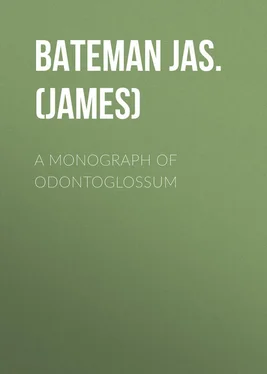The mention of the illustrious traveller's name reminds me of the obligations under which he laid me when I first visited Berlin, in the spring of 1836; for, young as I was, he deigned to pour into my delighted ears all the stores of Orchid-lore collected during his memorable wanderings among the Andes of New Grenada and Peru. Here, he said, the greatest store of beauteous Orchids was to be found, and we are now beginning to realize the truth of his remark.
Cool Orchids from the interior of South America, have either to be carried across the Andes, where the intense cold of the passes is often fatal to them, or to be conveyed by a tedious voyage down the great rivers, where the heat is greater than their constitution – often delicate – can endure. In this way whole importations have been lost, including, I am sorry to say, one or two cargoes of the exquisite Odontoglossum Warczewitzii (figured in Reichenbach's "Xenia") which still unhappily remains a desideratum.
As most of the Odontoglossa require to be treated in the same way, I transcribe, from the 'Guide to Cool-Orchid Growing' (Reeve, 1864), the following instructions for the culture of the genus: – "They will all succeed perfectly in a low lean-to house facing the north, the mean temperature of which need not exceed 60°. They should stand on a shelf of slate or stone, near the glass, but should always be protected from the direct rays of the sun. Constant humidity should be maintained by damping the shelves and floors, but the plants themselves will only require water in moderation, and what is given to them should pass away freely, for if it stagnates, or if the compost in which they grow becomes sodden, the roots will immediately decay. A gentle evaporation is greatly assisted by placing layers of moss – to be kept damp of course – on the shelves whereon the plants stand. Odontoglossa cannot endure wooden blocks, but will thrive in a compost of which one-half consists of small broken potsherds, the remainder being a mixture of shredded sphagnum (dusted with fine sand) and fibrous peat. About one-third of the entire depth of the pots may be filled with this mixture, the other two-thirds containing nothing but large pieces of broken pots, so as to admit as much air as possible to the roots. The pots in which the plants are grown should stand on other pots (inverted) placed in saucers of water, in order to secure humidity and protect them from wood-lice. Nearly all the species flower during the winter or spring months, a circumstance that greatly enhances their value. Many, e. g. O. pulchellum , are deliciously fragrant, and the flowers of nearly all the species remain in perfection for weeks, whether left on the plants or cut for bouquets. In so vast a genus we shall, no doubt, meet with many idiosyncrasies, but nine-tenths of the species will flourish under the treatment indicated above, and which may be regarded as suitable to the majority of cool Orchids. Most Odontoglossa are, like the Masdevallias , very impatient of the knife, and cannot therefore be rapidly multiplied. They have also a peculiar aversion to fumigation by tobacco, which causes their leaves to fall off."












